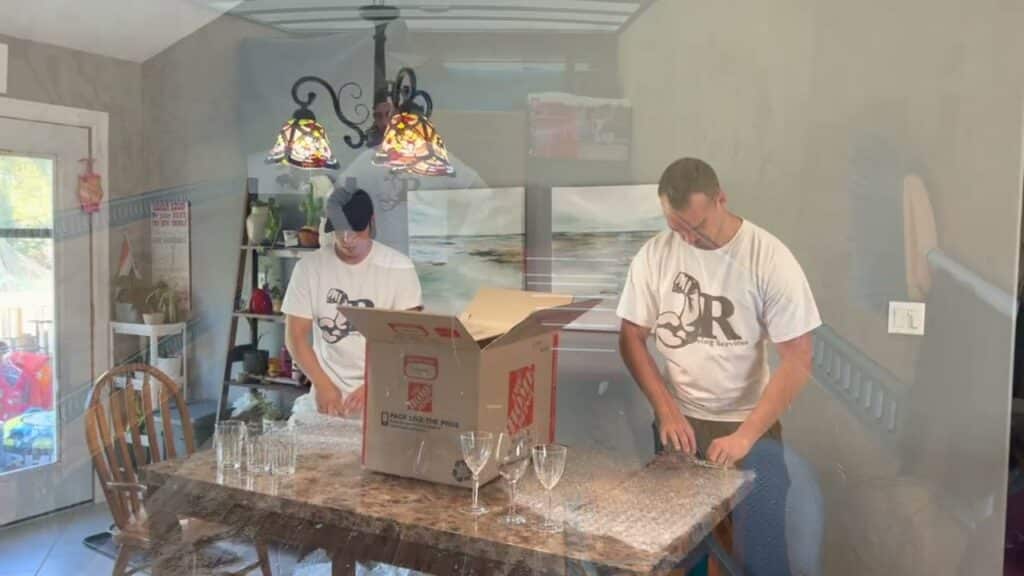At JR Moving Services we are packing professionals
We know how to properly pack any item you can think of. We are packing professionals and in this blog we will provide you with proper packing techniques for an assortment of different products if you are planning to move 4 hours or under away. We encourage our readers to ask us packing questions of items that we do not cover in this blog. With our St. Catharines & Niagara moving company in business since 2012, we have amassed plenty of experience packing our customers and obtaining proper packing techniques.
1) Packing canvas/Glass cased pictures
To ensure canvas pictures stay secure during transport, pick up large sheets of bubble wrap in the desired size and then wrap it around the entire frame. You should also be sure to use packing tape along the outer edges of the picture frame so that the bubble wrap stays in place. On the 4 corners of the picture we encourage you to mold corrugated paper and tape the paper into place. Once properly wrapped, find a cardboard box large enough to fit the picture without bending it; properly lined boxes can help minimize movement during transit and protect against water damage. If you are not able to find a picture box for your oversized pictures make sure to follow the above steps before placing in the picture box. Instead of only using corrugated paper for the corners, make sure to wrap corrugated paper around the entire picture and tape it into place (The more layers, the better)
2) Packing breakable kitchenware
Packing breakable kitchenware can be one of the most cumbersome tasks. Our moving company gives you some tips and tricks, so your plates and glasses can arrive safe and sound. First, each item that is either glass or ceramic should be wrapped in bubble wrap to ensure any knocks won’t cause breakages. For further protection you can also create another layer by using wrapping paper around the bubble wrapped product. Foam can be used to fill areas around the items, and add extra cushioning in between the plates and dishes. You have to make sure the layer of foam is larger than the dishes themselves. Lastly, try and place heavier items in boxes that are filled with packing materials so they don’t move around too much during either the packing process or their journey to their destination. Following these steps should ensure that all of your breakable kitchenware arrives safely without any damage.
Tip to reduce carbon footprint: try to replace the plastic bubble wrap with towels, linens, bedsheets, and your stay at home clothing
3) Packing clothing
To make sure that everything is packed in an efficient and organized manner, utilize any space-saving techniques necessary. Start by folding each article of clothing neatly, as this will help maximize how much you can fit into the packing boxes. Making use of smaller boxes for lighter items such as t-shirts and sweaters, and larger boxes for jeans, jackets and coats can also lessen how many boxes you will need overall. If you don’t have enough room in the box for larger items like coats or if they are too bulky and would take up too much space in a box, consider using garment bags as an alternative. Placing garments with thicker fabrics on the bottom will also provide protection against crushing or wrinkling of lighter clothing that would be placed on top in the same box. Lastly, packing any spare plastic hangers can make unpacking simpler when you arrive at your new home. With these tips in mind, how to pack clothing when moving should be made much easier.
Tips to reduce your carbon footprint: Use reusable plastic totes and reusable grocery bags
4) Packing small appliances like microwaves and toasters
Tape corrugated paper or cardboard around the entire kitchen appliance, than wrap arround with a blanket. Place package inside a reusable plastic bin.
5) Packing books
The key is to start with the heaviest items and consider how you want to organize the books. You can stack smaller books on top of larger ones but make sure they are secure in the box so they don’t shift around too much during transit. If you have larger books or precious leather-bound copies, wrap those separately in tissue paper for extra protection then place them securely in a box. For boxing your regular paperbacks, choose medium sized boxes that aren’t too deep as this will minimize how much packing material you need to fill all the empty space. Make sure to use your judgement when you are gaging the weight of the boxes if you are using cardboard boxes so the books do not fall through. With these simple tips, now you know how to pack your books safely and securely when on the move!
6) Packing Food
Prioritize what items you are taking with you by using airtight containers or zip-top bags for non-perishable items such as cereals and snacks. When packing perishables like fruits, vegetables and meats, you’ll want to double-bag them as an added precaution to prevent leakage while they’re in transit. To help reduce spoilage make sure your juices and dressings are sealed so they don’t spill during the move. If you are transporting a fridge or freezer keep the fozen or refridgerated items in them, but make sure to take them out when you are moving the fridge or freezer. Doing this will ensure your food stays cold. If you are not transporting a fridge or freezer than make sure to setup ice packs in coolers. Try to plan ahead of time how much food you will need for the move and how long it will take so that you can properly plan meals for everyone involved.


